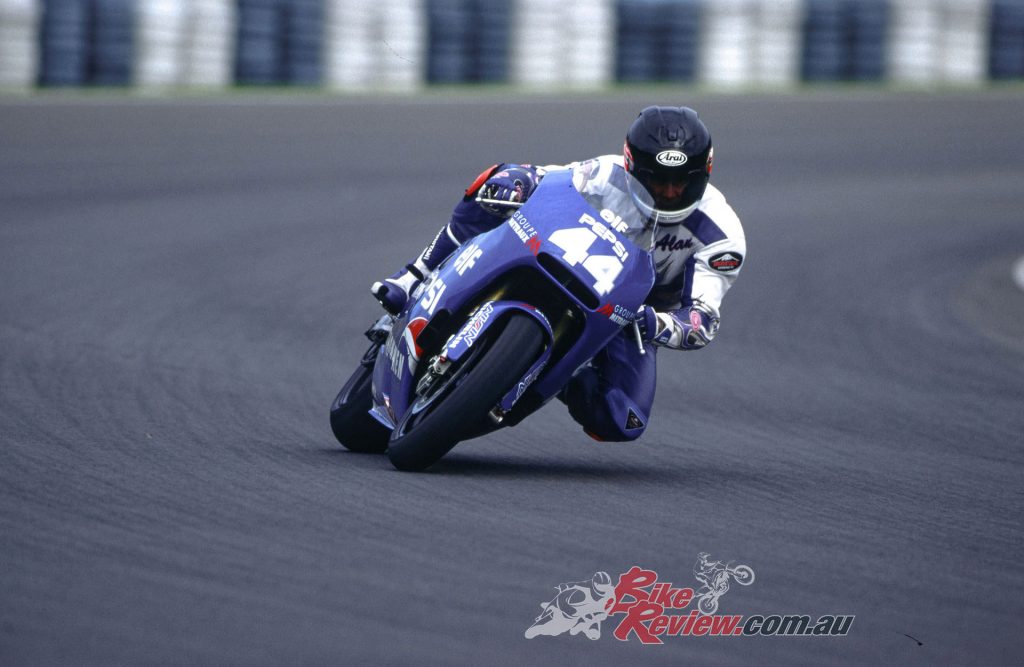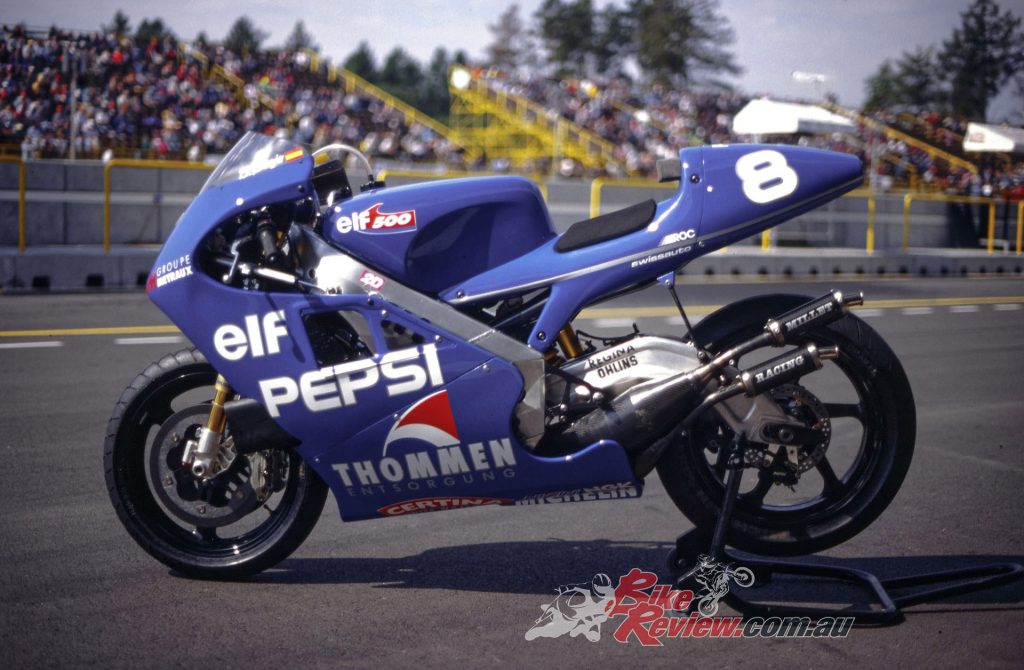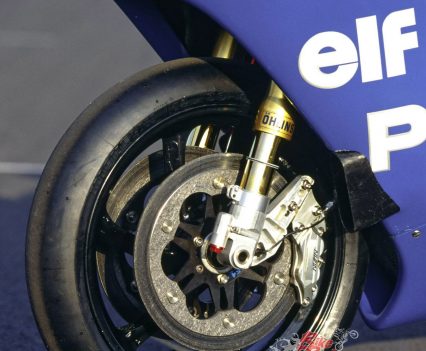The 1996 ELF Swissauto 500GP was a bike built out of a need for competition against the Japanese manufacturers dominating the sport in the '90s, check out the history on the bike below... Words: Alan Cathcart Photography: Chris de Beer.
At a time when Ducati and Aprilia have now been joined by fellow-Eurobrand KTM in taking the fight for MotoGP supremacy to the three Japanese factories in 2021, it’s timely to look back exactly 25 years ago, when the Swissauto ELF 500 GP took to the stage.
Later rechristened the Swissauto, the MuZ and then the Pulse as it shifted sponsorship allegiance, the 1996 ELF 500 represented a return to GP racing on two wheels for the French petroleum giant, just as it announced its retirement from Formula 1 after 29 years, 128 GP victories and seven World titles via its involvement with Williams, Benetton, etc. The fact that the then-new ELF 500’s unique wide-angle V4 engine design came from the same company that today is a wholly owned subsidiary of the USA’s giant Polaris Corp., in which capacity Swissauto has created all the standalone V-twin engines powering the company’s born-again Indian and new-generation Victory models, may seem improbable, but it’s nevertheless true.
Check out Alan Cathcart’s test on the 1996 ELF Swissauto 500GP Racer here…
For Swissauto was always a company that did things differently – but right, making it little wonder that in February 2010 its powersports division was acquired by Minneapolis, USA-based Polaris, for whom Swissauto had already developed the high-performance four-stroke Weber engine that Polaris had used in several of its snowmobile models. When Polaris purchased Indian Motorcycles in 2011, it was Swissauto that was responsible for conceiving its all-new 111ci/1820cc Thunder Stroke V-twin engine unveiled just two years later in March 2013, which today powers the Indian Chief range of motorcycles which represent the opposite end of the scale from the 500GP V4 two-strokes they’d built and raced two decades earlier.

“When Italy’s cash-strapped Cagiva exited 500GP racing at the end of 1994, it left behind a big gap – one that Aprilia’s underdog RSV400 twin-cylinder project didn’t come close to plugging.”
The Japanese factories agreed that 500GP badly needed a competitive four-cylinder contender made in Europe, to add a vital extra dimension to the grid, just as Ferrari has always done in Formula 1 against the array of British-based teams. But in 1996, thanks to a Franco-Swiss triumvirate of talents comprising ELF (which paid the bills in return for putting its name on the bike), ROC (which built the chassis) and Swissauto (who delivered potent performance from an innovative engine design), that bike duly appeared. With Spanish rider Juan Bautista Borja and Swiss Adrian Bosshard starting out the season – the latter replaced mid-year after a series of non-finishes by 24-year old British ex-motocrosser Chris Walker, just three years into his ongoing road racing career – the ELF 500 was the Euro-racer par excellence. Only the pistons and brakes were made in Japan!
That’s because its V4 engine was entirely manufactured at Swissauto Wenko AG’s Burgdorf base in the Emmenthal region of German-speaking Switzerland, where a youthful staff of 15 people worked on new engine projects conceived by its CTO Urs Wenger, who founded the firm in 1987 with his partner Beat Kohler, the company’s CEO. As a creative laboratory of avantgarde engine technology, based on the principle of original thought, Swissauto concentrated exclusively on developing radical new engine designs for cars, bikes and boats. Its designs owed nothing to what had gone before – even if Wenger did serve a two-year stint as the sorcerer’s apprentice, working for Swiss performance guru Fritz Egli on the Egli-Colani record breaker powered by a turbocharged Kawasaki engine. He didn’t just spanner the bike, either – look in the record books, and you’ll find that in December 1986 21-year old Urs Wenger rode the bright red 320bhp Swiss streamliner to a clutch of World records before leaving Egli the following year to found Swissauto.

“The V4 engine was entirely manufactured at Swissauto Wenko AG’s Burgdorf base in the Emmenthal region of German-speaking Switzerland.”
In the early ‘90s Swissauto developed its own version of the Krauser 500cc inline-four crankcase reed-valve two-stroke motor by then ubiquitous in the Sidecar GP class, and Switzerland’s four-time World champion Rolf Biland raced the result, winning a further hat-trick of World Championships in 1992/3/4. “We made everything new inside, including the gearbox,” said Wenger, “and though we used the original Krauser crankcases, we modified the upper half quite heavily, because we were the first people to use the 54 x 54.5 mm configuration in the Sidecar class. We won first time out with the engine, when Biland won the French GP at Paul Ricard in 1991, and from delivering 160 bhp at the clutch for that race, we developed it to give more than 180 bhp by the end of the ’94 season, when we debuted the prototype of our new V4 engine in the final GP of the season at Barcelona. Biland would have won first time out with that, too, except the revcounter got wet in the rain and shorted the ignition, so he had to stop five laps from the end when he was 15 seconds in the lead, after starting on pole!”
However, although it had made its track debut in a sidecar for R&D purposes at Barcelona (Biland had already sealed Swissauto’s third World title one race early with the old in-line motor), Wenger claimed the V4 engine was originally only intended for solo use. “The inline four-cylinder engine is absolutely the best format for Sidecar racing,” he asserted, “but only for that. However, the V4 engine is much lighter, so even though we designed it for solo racing, the Sidecar guys wanted to use it, too. We took pole position with it in every Sidecar GP in 1995, won five out of the seven races, but lost the title because our drivers Biland and Guedel took points away from each other, and let Darren Dixon win on the ADM!” However, fast as the five Swissauto V4-powered rigs were in every race, they also suffered a series of mechanical failures that were an inevitable part of the new engine’s R&D.
“The fact that Borja scored points so regularly in the ELF 500’s debut season in 1996 was attributable to that vital year of three-wheeled development in ’95.”
Wenger & Co. had made a deal with Harris to buy the Yamaha chassis that John Reynolds raced for the British team in ’93, which was modified to accept the Swissauto engine for testing purposes, with a view to its replacing the YZR500 Yamaha V4 engine as a much more cost-effective option for Harris’s GP privateer customers. Much closer at hand, though, was Serge Rosset’s Annemasse-based ROC operation just 200km away just the other side of the French border from Geneva. At the point that a dedicated all-new chassis was needed for the Swissauto engine, which was physically smaller than the Yamaha motor, it made sense to commission ROC to build this, and eventually to run the solo 500GP team after ELF sponsorship was confirmed. The first ROC-Swissauto racer was completed in mid-1995, and tested by Adrian Bosshard and Bernard Garcia before appearing in public for the first time in the colours of its new sponsor ELF at the final GP of the ’95 season at Barcelona, exactly one year after Biland had debuted its engine in Sidecar guise.

“The first ROC-Swissauto racer was completed in mid-1995, and tested by Adrian Bosshard and Bernard Garcia before appearing in public for the first time in the colours of its new sponsor ELF at the final GP of the ’95 season”
For meanwhile, closer to home, someone else had kept his eye on the Swissauto V4 project, in the form of: Swiss businessman and GP insider Michel Métraux, president of IRTA and committed sponsor of all the top Swiss riders in GP, as well as owner of the mid-’80s Parisienne 250GP team. More to the point, though, Métraux’s privately-owned Swiss Automotive Group of companies with over 800 employees included the Swiss distributor of ELF lubricants, one reason all the bikes he’d sponsored over two decades always carried ELF stickers. From there to enlisting the support of the French multinational to underwrite the development of an all-new, all-European 500GP bike may have been a big step, but Métraux was the man to pull it off, and at the ’95 Catalunya GP the deal was announced. A decade after it pulled out of competing in 500GP with its own avantgarde motorcycles, ELF was back in two-wheeled GP racing, with its name soon joined on the side of the bikes by another prestigious sponsor making its return to motorcycle racing after supporting the Suzuki 500GP team, Pepsi-Cola.
When lead rider ‘Baptiste’ Borja finished tenth on the ELF 500’s debut in Malaysia at the start of the 1996 season, it augured well for the new bike in its development year. Thereafter, Borja put in a series of increasingly competitive rides on a motorcycle which, while suffering inevitable teething troubles, began finishing regularly up amongst the Japanese works bikes, culminating in Baptiste’s solid ride to eighth place at Donington in July, finishing the British GP ahead of four works Hondas, as well as lapping faster than two of the four factory Yamahas.

“While suffering inevitable teething troubles, Borja began finishing regularly up amongst the Japanese works bikes, culminating in Baptiste’s solid ride to eighth place at Donington in July, finishing the British GP ahead of four Hondas.”
This made up for the disappointment of the previous race at Paul Ricard, when a fifth place finish was on the cards in ELF’s home GP, before the Spaniard ended up in the gravel pit. Still, he scored two more top ten finishes out of seven points-scoring results in the 15-race season, en route to 14th place in the 1996 points table, just one place behind future World champion Kenny Roberts Jr. and ahead of the entire fleet of Harris- and ROC-framed privateer Yamahas. Novice 500GP rider Chris Walker had twice finished in the points on the ELF, before he was replaced for the final race of the season, the Australian GP at Eastern Creek, by local rider Marty Craggill, who DNF’d
It had been a promising first season for the bike, and for 1997 Borja remained in the team, to be joined by a new German teammate, Jürgen Fuchs. Reliability was still an issue, but improvements came, and the two ELF 500s finished in the points 13 times – six of them inside the top ten. The high point of the season came in Brazil, when Fuchs scored the bike’s best-ever GP finish with 6th place. Borja finished the season 17th in the championship table, this time equal on points with KR Jr., by now riding his dad’s new self-built Modenas KR3 triple. Though it was the end of the road for the ELF team, with Métraux unable to convince the French to continue funding the project, what were essentially the same bikes returned to the grid in 1998 rebaptised as the MuZ 500.

“Doriano Romboni started out the 1998 season riding the singleton MuZ, but was replaced after a couple of races by Swiss rider Eskil Suter, who took it to three lower order points scoring finishes.”
In 1999, the Swissauto solo came as good as it ever got, with Dutch rider Jurgen van den Goorbergh twice qualifying in pole position on the bike in Catalunya and again in Brno, en route to two lap records and nine points scoring finishes in the sixteen races, including six top ten placings with a best finish of 8th, to wind up 16th in the 500GP championship. Italian star Luca Cadalora raced the bike seven times in the first half of the season, with a best finish of 8th in Spain, while Kiwi Simon Crafar also had a one-off ride on the MuZ Weber, finishing tenth in the British GP at Donington, while Noriyasi Numata did likewise on home ground in Japan, also scoring points with a 13th place result. Aussie wild child Anthony Gobert joined the team for the last four races of the year, but DNF’d in his debut race on home ground at Phillip Island, before finishing tenth in Brazil in his last-ever 500GP race.

“However, 1999 saw the end of the project, and with one-litre four-stroke engines now dominating Sidecar racing, at the end of that season Swissauto retired from racing.”
However, 1999 saw the end of the project, and with one-litre four-stroke engines now dominating Sidecar racing, at the end of that season Swissauto retired from racing, having scored 29 GP wins (all in Sidecar racing), 41 pole positions (two in 500GP solos) and three Sidecar World titles with its V4 engine. There was a postscript, though, when Dave Stewart, ex-team manager of NZ’s BSL 500GP team, purchased the MuZ 500 project and rechristened it Pulse, under which guise Aussie Mark Willis and Brit Jason Vincent competed in nine of the 16 races in the 2001 500cc World Championship, before the money ran out halfway through the year. The Pulse V4 managed just one point-scoring finish, with Willis 13th in the Italian GP, before the curtain this time finally came down on what was certainly the fastest and most powerful 500GP two-stroke ever to be produced outside Japan.

























